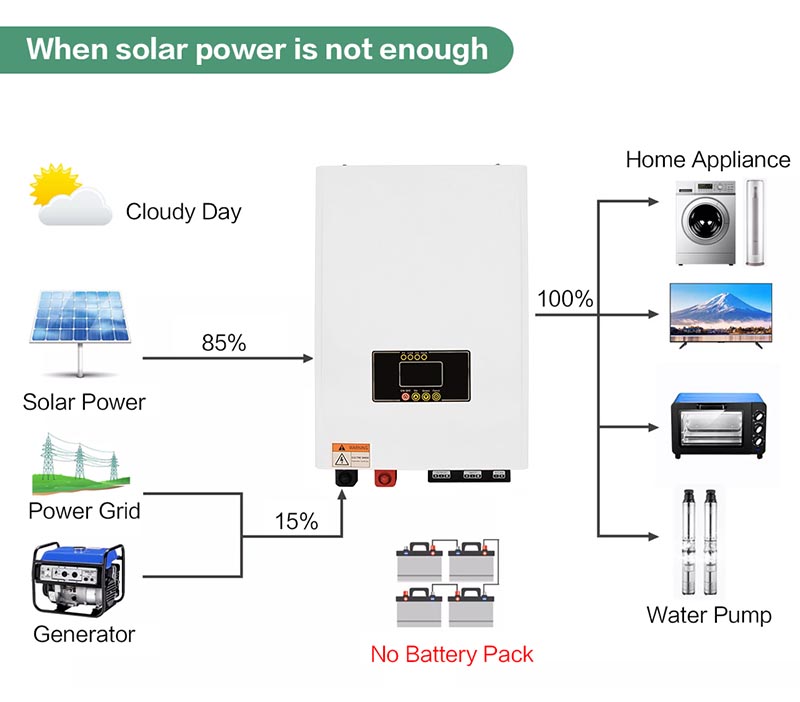How Solar Inverter and MPPT Controller Choices Affect Power Generation?
 Jul 09,2022
Jul 09,2022

 Rekesun
Rekesun
Generally, single-phase inverters below 6kW and three-phase inverters below 10kW are mostly used in households. Two MPPTs are used, and each MPPT is equipped with one string. Small industrial and commercial projects generally use 20kW to 40kW inverters, the number of MPPTs is 2 to 4, and each MPPT is equipped with 2 to 4 strings. Large-scale power stations generally choose 60kW to 80kW high-power string inverters. The number of MPPTs ranges from 1 to 6, and each MPPT is equipped with 2 to 12 strings.
Choosing different MPPT routes has a certain impact on the power generation of the system. From the perspective of solving the mismatch problem, the fewer strings behind an MPPT, the better. In terms of stability and efficiency, the more strings behind one MPPT, the better, because the more MPPTs, the higher the system cost, the worse the stability, and the more loss.

Advantages of MPPT with fewer strings and more strings
1. Less functional loss: There are many MPPT algorithms, such as interference observation method, incremental conductance method, conductance incremental method, etc. No matter which algorithm it is, it judges the change of sunlight intensity by continuously changing the DC voltage, so there will be errors. For example, when the voltage is actually at the optimal operating point, the inverter will still try to change the voltage. To judge whether it is the best working point, if there is more MPPT, there will be more loss.
2. Less measurement loss: When MPPT is working, the inverter needs to measure current and voltage. Generally speaking, the greater the current, the greater the anti-interference ability and the less error.
3. Less circuit loss: The MPPT power circuit has an inductor and a switch tube, which will cause losses during operation. The more MPPT circuits, the greater the loss. Generally speaking, the greater the current, the smaller the inductance and the less the loss.
Advantages of MPPT with multiple strings and fewer strings
1. Each MPPT circuit of the inverter operates independently and does not interfere with each other. Strings can be of different models, different numbers, or different directions and tilt angles, so the number of strings is small and the system design flexibility is greater.
2. Reduce DC side fuse faults: The most common fault in photovoltaic systems is DC side faults. One MPPT is configured with 1 to 2 strings. Even if a component is short-circuited, the total current will not exceed 15%, so no configuration is required. Fuse, fuse common failure modes are divided into overcurrent fuse, aging fuse, over temperature fuse. Overcurrent fuse is a protective fuse that occurs when overload, short circuit, etc. exceed the rating; aging fuse means that in the long-term work, it is the same as its own aging, the current interception capacity is reduced, and there is no overcurrent. Fusing: The current of the fuse has a great relationship with the temperature. If the fuse works at high temperature, the current interception capacity will decrease, and the possibility of faulty fuse will be relatively large.
3. Accurate fault location: The inverter independently detects the voltage and current of each input channel, can sample the current and voltage of the string in real time, and timely find problems such as line faults, component faults, and occlusion. Through the horizontal comparison of strings, comparison of meteorological conditions, comparison of historical data, etc., the detection accuracy is improved.
4. Matching power optimizer is more suitable: At present, one of the solutions to eliminate the matching effect at the component end is to use a power optimizer. The photovoltaic optimizer can convert low current into high current according to the needs of the series circuit, and finally each power optimizer The output terminals of the inverter are connected in series and connected to the inverter, and multiple strings are connected to the optimizer. According to the principle that the voltage of the parallel circuit is consistent, when a certain string is shaded by shadows and causes the power to drop, the optimizer changes the voltage, and the total voltage of this circuit will reduce, and will also affect the voltage drop of other circuits of the same MPPT, resulting in a drop in total power.



 Home
Home Five development trends of photovoltaic high-frequency inverters
Five development trends of photovoltaic high-frequency inverters 







 syplighting.en.alibaba.com
syplighting.en.alibaba.com



